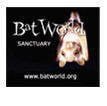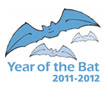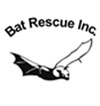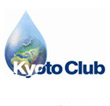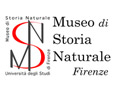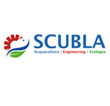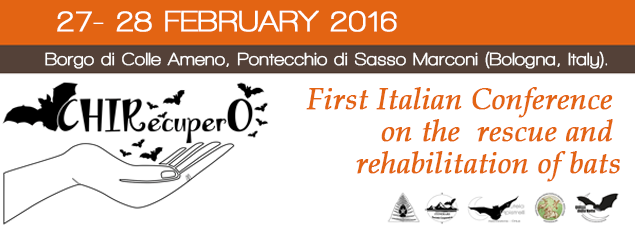
CHIRecuperO: First Italian Conference on the rescue and rehabilitation of bats
On behalf of the organizing committee, we are pleased to invite you to participate at the first Italian conference on the rescue and rehabilitation of bats, CHIRecuperO (BAT Rescue), that will take place on 27 and 28 February 2016 in Borgo di Colle Ameno, Pontecchio di Sasso Marconi (Bologna, Italy).
The conference is organized by Nature and Archaeological Centre of Pistoiese Apennines, Itinerari Cooperative, non-profit organization Tutela Pipistrelli, Monte Adone Rescue Centre, Association Quelli della Notte and in collaboration with the Lazio Region – Regional Parks Agency and the Institute for the Protection and Environmental Research (ISPRA). The members of the Scientific Committee are: Gianna Dondini, Piero Genovesi, Daria Pecchioli, Marco Scalisi, Alessandra Tomassini, Simone Vergari, Paola Zintu. The members of the organizing committee are: Elisa Berti, Monia Cesari, Marco D’Amico.
This is the first Italian event covering the topic of rescue and rehabilitation of bats: the objective is to disseminate and inform about the correct techniques of recovery, rehabilitation and reintroduction of individuals found injured or distressed and housed in rescue centers for wild animals.
In particular the conference will cover the following topics: legal aspects and health, rearing of orphans, treatment for most common diseases, the criteria for the release and management of bats in captivity. Aspects related to formal and non-formal education and the correct educational methods will be covered as well. A photo exhibition will be arranged in occasion of the event.
The event received patronage by the Municipality of Sasso Marconi, GIRC (Italian Bats Research Group), Biodiversity Office of the Italian Forestry Corps (CFS), LIPU (Italian League for Birds Protection), WWF, Order of Veterinary MDs – Province of Bologna, Order of Veterinary MDs – Province of Prato, Managing body for Parks and Biodiversity – Eastern Emilia, SSI (Italian Speleological Society), FSER (Speleological Federation of Emilia Romagna region).
The organizing committee would like to thank for collaboration: Francesca Mecca, Paolo Taranto, Francesco Grazioli, Biosid di Davide Sita, Banca Popolare dell’Emilia Romagna Ag.215 Pianoro, Alce Nero, Coffee Glamour.
Besides the presentation of the scientific session, the conference will bring together experts and enthusiasts and give them opportunity to share good management practices and personal experiences . For a first time on a national scale they will have the occasion to share the used methodologies. Specific objective of the conference will be to propose the first draft of the national guidelines for the care and rehabilitation of bats.
The conference related activities will include also:
- A section for exhibition of scientific posters
- A photo exhibition that will be held in the premises of the Conference
- An evening dissemination event on bats for the general public
- Two awards named in memory of Susan Barnard
Conference Program
The conference will be divided in five thematic sessions:
Saturday 27 February 2016
Morning:
Opening and welcome speech by authorities
1. The BATS: BIOLOGY OF ITALIAN SPECIES
Introductory presentation, by the Scientific Committee, on the biology and ecology of bats in Italy
2. BATS AND MAN: LEGISLATION, FINDINGS, HEALTH RISKS
Reports by the organizers
Afternoon:
3. ORPHANS: HAND REARING, WEANING AND REHABILITATION FOR RELEASE IN NATURE
Reports by the Scientific Committee
Despite the relatively big number of rescued newborn bats that fell from their shelter, up to day there is no generally accepted nursing method. Each rehabilitation center implements different ways, not only in holding and care, but also in rehabilitation techniques and methods of release. The comparison of the different methods used and their relative success is an opportunity to try to standardize the various techniques, arriving at the best one.
Oral communications section
In this section we invite you to present the experiences and techniques used in the care of orphans until their release into the wild.
4. MAINTENANCE IN CAPTIVITY : CORRECT MANAGEMENT, PROSPECTS OF RESEARCH AND EDUCATION
Reports by the Scientific Committee.
Despite the care techniques, it’s not always possible to release the rescued bats. Many rescue centers house permanently in captivity this individuals. Their management has several critical aspects: nutrition, diseases, management during the winter period, births in captivity. The bats in captivity have an important role for dissemination and public awareness, as well as for scientific research.
Oral communications section
In this section we ask you to present experiences on care of individuals in captivity: species management during the winter period, treatment of diseases, nutrition, socialization among different species, environmental enrichment.
POSTERS SECTION
The posters may address aspects of care, breeding, release techniques, ethology of the species, captive maintenance, management of conflicts of colonies in buildings, dissemination events.
Evening:
DISSEMINATION EVENT:
“WINGS OF THE NIGHT: LET’S KNOW BATS”
Presented by the Scientific Committee
“SUSAN BARNARD” AWARD
There will be two awards in memory of Susan Barnard.
The first one will be given for the best oral communication or poster presented at the conference. The second will be given to private or public organisations that distinguished themselves for concrete actions in order to protect bat colonies. Both awards will be awarded by the Scientific Committee in agreement with the organizing committee.
Sunday 28 February 2016
Morning:
5. SURGERY AND DISEASES
Reports by the Scientific Committee
The causes that need surgical treatment of a trauma or a disease can be manifold, and individualapproaches can be different. Comparing of the different situations and results is the first step to try to standardize the surgical and clinical methodology and thus improve the chances of success of the surgical operations. It is also not unusual to come across particular diseases encountered for the first time. The opportunity to learn about the various causes and share experiences is a great occasion to be able to properly treat similar cases that may occur.
Oral communications section
This session, specifically for veterinarians, is dedicated to the surgical experiences and treatment of diseases that can affect bats.
– EDUCATION METHODS FOR A RIGHT KNOWLEDGE ON BATS
Reports by the organizers.
Public awareness is crucial for the conservation of bats: in European cultures, bats have long been associated with witchcraft and even today many phobias are related to this order of mammals. Experience shows that public opinion changes dramatically when people have the chance to directly observe a bat: bat nights, meetings with schools, communication and dissemination events are among the most used methods to make them known.
Oral communications section
Participants are invited to present successful educational, awareness raising experiences and the correct ways of transmitting information about the species, both to schools and towards the adults.
Afternoon:
THE ROUND TABLE: guidelines for Rescue Centers
Prepared by the Scientific Committee
How to partecipate
All participants are asked to provide, by 20th of December 2015, the abstracts of original scientific contributions, and whether the contribution will be presented as oral presentation (lasting 15 minutes) or as a poster (size 100 cm high and 70 cm wide). In case the number of presentations exceeds the available time for the different topics, the Scientific Committee, in agreement with the Organising Committee, reserves the right to select proposals on the basis of received abstracts. The applicants that are not accepted as speakers at the conference will be invited to exhibit a poster.
The registration details and the web site of the conference will be available soon with detailed information, registration forms and regular updates.
How to send your application
Applications can be sent only by email to the email chirecupero@gmail.com
The Conference registration is REQUIRED for all participants except for the free evening event open for all participants and the general public. The entry fee is € 35.00, and includes admission, conference materials, abstracts, four coffee breaks, two lunches, receipt of proceedings.
For registrations after January 15, the fee will be € 45.00. A number of admissions depends on the capacity of the conference rooms; if case of the registrations reach maximum numbers of participants, they will be closed.
Option of directly joining the day of the conference, subject to availability of places.
Preparation of the abstract
Before you begin the process of sending your contribution, prepare the text of the abstract, as a document in Word or RTF format, so set:
– The right, left, top and bottom of 2 cm each
– Title in Times New Roman, 12 uppercase centered;
– Authors (last name followed by the initial of the name) in Times New Roman, 11 uppercase centered;
– Addresses and affiliations in Times New Roman, 10, centered single-spaced;
– Text in Times New Roman, 10, justified, single-spaced; shall not include bibliographical references, tables and figures.
The text, complete with title, authors and affiliations, should not exceed 3300 characters including spaces.




























